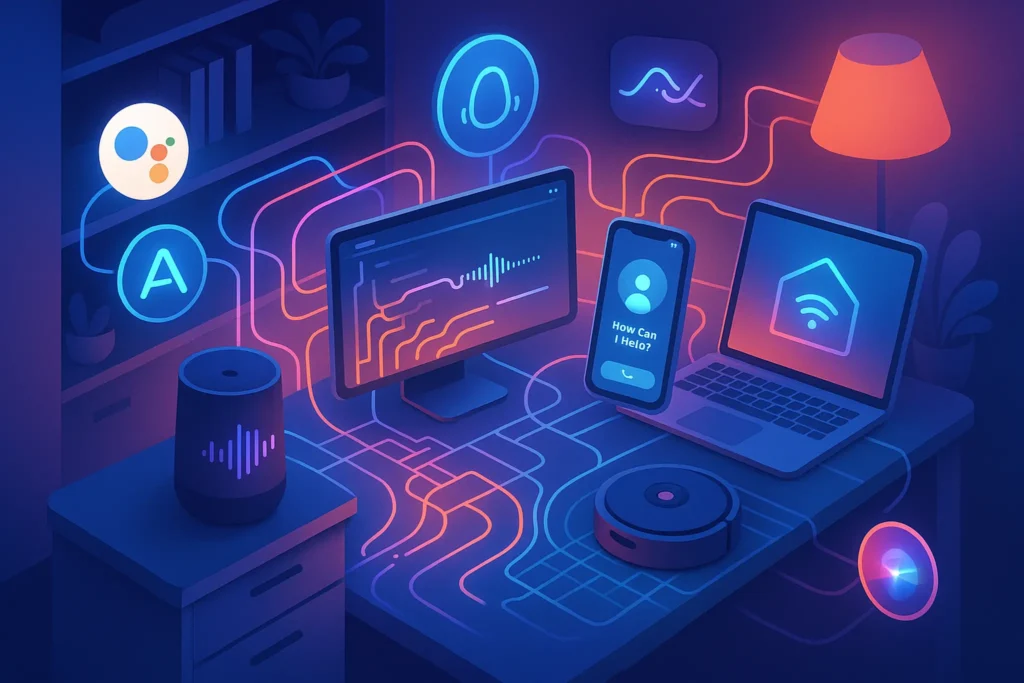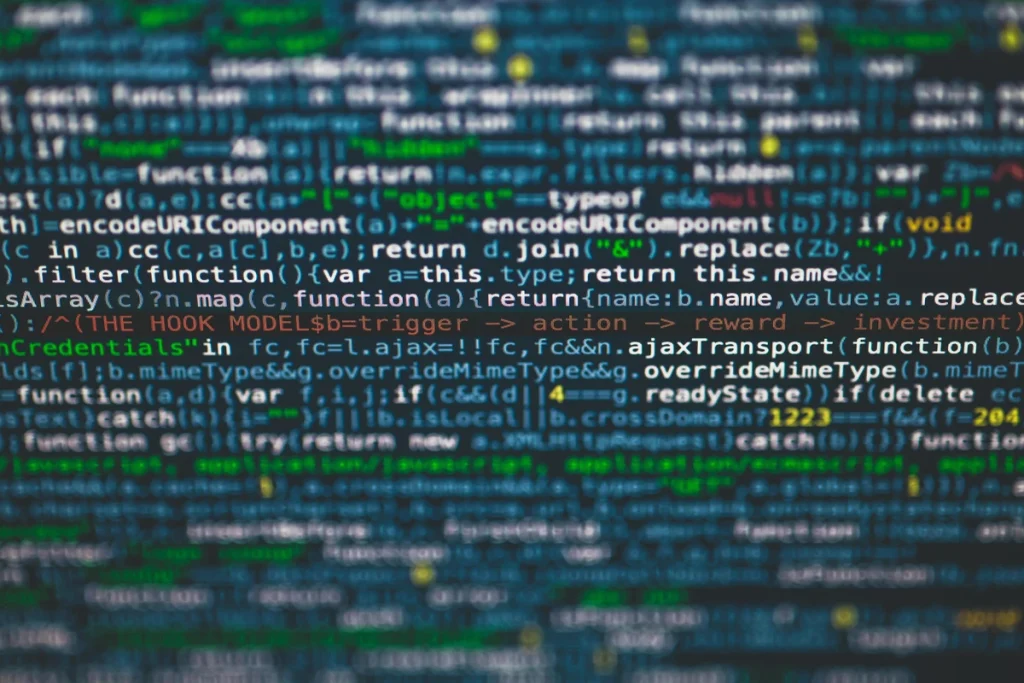🧠 Intro: AI Isn’t Coming — It’s Already Here
When we hear “AI,” we often picture futuristic robots or sci-fi assistants.
But in reality, AI is already woven into your everyday life—and you probably used it 10+ times today without even noticing.
From that YouTube recommendation you just watched, to your phone suggesting which photo to delete, to your robot vacuum mapping your living room—artificial intelligence is already quietly running in the background.
In fact, studies in 2025 show that over 77% of consumer tech products now include AI-powered features—even if they don’t label them as such.
This post explores the hidden (and not-so-hidden) ways AI is part of your daily flow, and how to use it smarter.
🧩 Everyday AI You Don’t Even Notice
Artificial intelligence isn’t just in futuristic tools—it’s already embedded in the devices and platforms you use every single day. From your camera’s portrait mode to your email’s spam filter, AI quietly enhances your experience behind the scenes. You don’t need to “use AI” anymore—because it’s already using your data to help you live smoother.
Let’s start with examples that most people overlook—yet they’re among the most advanced AI implementations today.
🗣️ Voice Assistants: Your Everyday AI Butler
Voice assistants like Siri, Google Assistant, and Alexa aren’t just gimmicks—they’re full-fledged AI-powered interfaces that interpret context, anticipate routines, and handle your micro-tasks. They’ve evolved from simple command executors to proactive assistants that understand your habits and preferences. In 2025, your voice assistant knows you better than most apps do.
Whether it’s Siri, Google Assistant, or Alexa, these voice helpers do far more than set timers in 2025.
Real-world AI uses today:
-
Siri: Summarizes long messages, gives context-aware driving routes, and automates app shortcuts
-
Google Assistant: Responds to natural language queries, integrates with smart home, and even translates live conversations
-
Alexa: Manages full smart home routines, reads audiobooks, and adapts to voice profiles in multi-user households
These assistants learn your preferences, recognize your tone, and adapt over time. They’re not just reactive—they’re predictive.
💡 Curious how to fully automate your routines? Check our post on How AI Can Automate Your To-Do List.
🎬 AI in Entertainment: Streaming Knows You Better Than You Think
Ever wondered why Netflix nails your binge picks? Or how Spotify queues up the perfect vibe? That’s AI at work—tracking your behavior, learning your patterns, and crafting experiences tailored just for you. Entertainment platforms use advanced recommendation engines powered by machine learning, and the more you interact, the better they get.
When Netflix suggests your next binge or Spotify lines up the perfect playlist, that’s machine learning in action.
AI tracks what you watch, when, where, how long—and adjusts recommendations in real time.
-
Netflix: Uses multiple neural nets to recommend thumbnails, content, and even subtitle styles
-
Spotify: Analyzes genre patterns, mood tags, and playback behavior for weekly discovery
-
YouTube: Combines watch time, engagement, and topic graphing to feed your homepage
Sometimes it feels like these apps know your mood before you do—and that’s no accident.
🔗 Want to know how creators can reverse-engineer this for reach? See our post on How AI is Transforming Productivity.
📱 Smartphones & Smart Cameras: AI Behind the Scenes
Your phone is an AI powerhouse, even if it doesn’t advertise it. From real-time photo enhancement and facial recognition to predictive battery management and keyboard suggestions, AI ensures your smartphone works smarter, not harder. These invisible optimizations make even mid-range phones feel snappy and intuitive in 2025.
Your phone uses AI for far more than Face ID.
Hidden AI Features You Use Daily:
-
Photo Cleanup: Detects blurry photos, suggests deletions
-
Camera Processing: Applies live HDR, portrait blur, and scene recognition
-
Typing Suggestions: Predicts full sentences in Gmail, Slack, WhatsApp
-
Battery Optimization: Learns your app usage patterns to prioritize background resources
Even budget smartphones now include AI-driven camera modules and adaptive system management.
This silent intelligence is what lets modern phones feel “faster” even with similar hardware specs.
🏠 Smart Homes: AI is in Your Thermostat, Not Just Your Speaker
Smart homes are no longer futuristic—they’re here. Devices like robot vacuums, thermostats, and smart lights use AI to learn your routines, predict your preferences, and optimize comfort while saving energy. The beauty? Once set up, they work in the background, making your home more responsive and efficient with every interaction.
If you’ve ever used a robot vacuum, a smart bulb, or a learning thermostat, you’ve already experienced embedded AI.
-
Robot vacuums like Roborock S8 or Roomba i7+ now map homes using SLAM algorithms and adapt cleaning paths over time
-
Thermostats like Nest or Ecobee analyze your schedule, habits, and even outdoor weather to keep energy use optimal
-
Smart lights adjust warmth and brightness based on time of day and your usage patterns
These devices evolve with you. What starts as a “dumb device with an app” slowly becomes an intelligent cohabitant.
📡 Want to go deeper? Don’t miss our Ultimate Smart Home Setup Guide for more automation insights.
📆 AI in Productivity Apps: The Silent Work Companion
From suggesting email replies to prioritizing your tasks, AI in productivity tools helps you work faster and focus better. Apps like Gmail, Google Calendar, Notion, and Microsoft Copilot use context-aware intelligence to reduce mental load and boost efficiency. It’s not about replacing your decisions—it’s about streamlining them.
From email sorting to smart scheduling, AI quietly boosts how we work.
Where AI shows up in your daily tools:
-
Gmail: Suggests replies, auto-sorts promotions vs important mail, flags suspicious links
-
Google Calendar: Suggests meeting slots based on attendee availability and time zones
-
Notion AI / Microsoft Copilot / Todoist AI: Drafts your tasks, recaps your day, and even generates daily priorities
Many modern apps now include AI copilots or assistants—designed not to replace your brain, but to unclog your bandwidth.
🛒 Hidden AI in E-Commerce: Personalized Everything
The online shopping experience you see is custom-built—just for you. AI in e-commerce shapes what you see, when you see it, and even how much you pay. Behind every product recommendation, dynamic price shift, and “others also bought” carousel lies a complex engine analyzing your behavior in real-time.
You’re not seeing the same Amazon or Zalando homepage as anyone else.
AI in Online Shopping:
-
Product recommendations are generated by your browsing, purchase history, and even cursor movement
-
Dynamic pricing adjusts offers based on supply, location, and demand
-
Search filters auto-prioritize what’s “most relevant”—not just “most popular”
Every swipe, scroll, and pause becomes a datapoint.
That’s why sometimes you think of a product—and it magically appears.
🔒 Why It Matters: Privacy, Ease & Awareness
AI brings speed and convenience—but also raises questions about transparency and control. It’s important to understand how and where AI interacts with your data. Balancing the ease of automation with mindful tech usage is key to maintaining agency in an AI-powered world.
AI makes things easier—but it also raises critical questions.
Benefits:
-
Less time sorting, searching, or planning
-
Personalized, efficient routines
-
Devices adapt to your patterns
Concerns:
-
Data over-collection (even from simple apps)
-
Opaque algorithms (you don’t know why you see what you see)
-
Loss of manual control or digital dependency
The key is mindful usage—knowing where AI helps, and how to maintain agency over your tools.
✅ Actionable Tips: How to Use AI Smarter in Daily Life
You don’t need to be a tech wizard to get more out of AI—you just need intention. With small tweaks, you can train your apps, audit your permissions, and adopt AI tools that save time without stealing focus. Think of AI as a productivity ally—not a mysterious black box.
Here’s how to get more out of AI—without getting overwhelmed by it.
🎯 1. Audit Your Apps
Go to Settings → Permissions → and check which apps use AI or background data processing.
🎯 2. Customize Your Recommendations
On platforms like YouTube or Netflix, train the algorithm: thumbs up what you like, remove irrelevant suggestions.
🎯 3. Use AI for Planning, Not Just Consuming
Try AI tools like:
-
Notion AI for brainstorming
-
Google Calendar Smart Suggestions for scheduling
-
ChatGPT (like this!) for writing, rewriting, or creating systems
🎯 4. Don’t Let Automation Hide Everything
Set reminders to occasionally review your routines and unsubscribe from things you no longer use.
🔍 AI Moments You Didn’t Know Were AI
Not all AI introduces itself. Some of the most sophisticated algorithms work invisibly—like Gmail warning you about a missing attachment or your phone automatically tagging dog photos. These quiet enhancements are the real magic of modern AI: low-key, high-impact, and increasingly woven into your everyday flow.
Sometimes the smartest AI is the one you don’t even recognize. Here are a few subtle ways you’ve used AI this week:
💡 When Gmail says “Looks like you meant to attach a file” — that’s intent-based NLP in action.
💡 When your smart speaker plays your “Sunday chill mix” without you asking — that’s habit detection + predictive modeling.
💡 When your Roomba learns to avoid your pet’s food bowl — it’s using reinforcement learning over time.
These tiny interactions aren’t flashy—but they’re where AI shines the most.
📈 Timeline: How AI Slowly Took Over Daily Life
A short history of how AI moved from novelty to necessity in just over a decade:
| Year | AI in Daily Life |
|---|---|
| 2011 | Siri introduced on iPhone 4s |
| 2015 | Google Photos starts auto-tagging faces |
| 2018 | Gmail launches Smart Reply + Smart Compose |
| 2020 | Alexa routines + smart home scheduling go mainstream |
| 2023 | ChatGPT & Notion AI make personal AI mainstream |
| 2025 | 77% of consumer tech devices now include AI elements |
You didn’t start using AI in 2023.
You just started noticing it.
🎯 Invisible AI vs Obvious AI: Understanding the Layers
Not all AI talks back or gives you an interface.
Some of the most powerful systems are completely invisible.
| Obvious AI | Invisible AI |
|---|---|
| ChatGPT, Midjourney | Gmail auto-categorization |
| Notion AI, Copilot | YouTube thumbnail curation |
| AI Art Tools | Android adaptive brightness |
| Virtual AI Avatars | Smart battery optimization |
Once you start noticing the invisible ones, you begin to realize:
AI isn’t coming for your job—it’s already helping your life.
🧠 Expert Quote
“The most powerful AIs are the ones you forget you’re using.”
— Ethan Mollick, AI Researcher at Wharton
This quote captures it perfectly:
We’re not heading into an AI future—we’re already in it.
🧠 Nerd Verdict
AI is no longer just a buzzword—it’s part of your fridge, your playlists, your calendar, and even your camera roll.
The magic isn’t in futuristic robots. It’s in the quiet, invisible helpers that let you focus more and think less about repetitive tasks.
Understanding where AI lives in your life helps you:
-
Use it more deliberately
-
Avoid digital burnout
-
Stay ahead as technology evolves
In 2025, the smartest users aren’t the most techy—they’re the most aware.
❓ FAQ: Nerds Ask, We Answer
💬 Would You Bite?
Which AI-powered feature do you rely on the most—voice assistants, smart calendars, or content suggestions?
Drop your go-to AI trick (or frustration) in the comments. 👇



